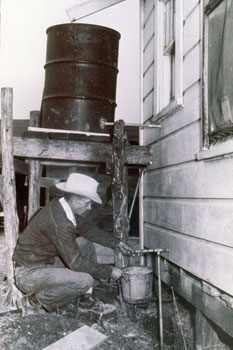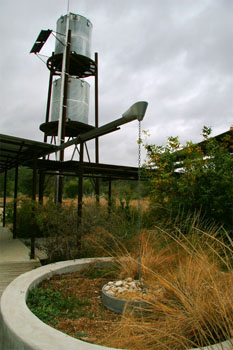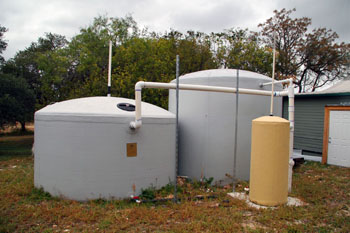
|
|
Rainwater Harvesting Although the rain itself is free, one of the main disadvantages is the cost of the tanks and accoutrements required. A complete system can easily cost $15,000 - $20,000. The storage tank is the single biggest cost, and if the intended use is to collect water for drinking, costs for disinfection must be added. These costs are usually not offset by a decrease in your normal water bill. Although the costs may be comparable to drilling a well, the sporadic nature of rainfall in Texas makes it difficult to rely on rainfall alone for a reliable and drought-proof supply. After a system is installed, care and maintenance is required, which makes it a less attractive option for some. And tanks can take up a lot of space, which is a problem in some settings. Also, some aspects of rainwater collection are at odds with other resource conservation goals. For example, it's best if the roof is not shaded by trees so you don't collect leaves and pollen; however, shade reduces energy consumption. Although there are certainly difficulties and trade-offs with rainwater collection, it can be a valuable supplemental water source, and there are several examples of homes in the Hill Country that have successfully relied completely on rainwater. Some South Texas examples One of the best examples is the one designed and built by John Kight, who completed a 3,500 square foot home in 2002 with enough roof space to collect 4,000 gallons from every inch of rainfall. Since the water is used for drinking, the system has filtration and disinfection systems that are not necessary when the only goal is non-potable uses like landscape watering (3). In 2006, the new Kendall County Development Corporation made promoting rainwater collection systems their first major initiative. The Corporation sees reducing the area's reliance on the increasingly stressed Trinity Aquifer as critical to continued prosperity. Plans included setting up entities to sell systems, getting banks to offer low-interest loans, and persuading local government to offer tax incentives (4). In 2007, Bandera county developer Eddie Leibold proposed construction of a 500 acre subdivision that would rely totally on rainwater. County commissioners expressed support for the concept but said they would probably require the drilling of a well for fire protection and as a back-up water supply (5).
Rainwater Collection Regulations In Texas, Section 341.042 of the Health and Safety code outlines standards for harvested rainwater. Prior to the adoption of the standards, potential rainwater collectors were facing legal obstacles when they resided in a municipality that has a centralized water supply system. Usually, city codes require that buildings be hooked up. In Bandera, real estate broker Gay Guilott faced fines of $200 per day after she occupied her new office building without hooking up to the municipal system, and she said the dispute illustrated backward thinking on the part of city officials. In response, city officials said the financial health of the utility depended on all residents and businesses paying the minimum monthly fee, and they pointed out that Ms. Guilott still benefits from fire protection services and doing business in a town where central water is available. (6). It became clear that innovative new ideas and strategies were required that support both rainwater collection and the critical public mission of traditional water purveyors. Section 341 stipulates that privately owned rainwater collection systems which rely on a public water supply system as an auxiliary source must have appropriate cross-connection safeguards such as a backflow prevention device or an air gap to provide a physical separation between collected rain water and the municipal supply. Users must give notice to the municipal supplier, and the public supply can only be connected to the storage tank, not the building's plumbing. Most of the provisions in Section 341 originated after the Legislature established the Rainwater Harvesting Evaluation Committee in 2005 and directed the Texas Water Development Board and three other agencies to formulate recommendations for minimum water quality standards for potable and non-potable indoor use, treatment methods, conjunctive use with existing municipal water systems, and ways in which the state can further promote rainwater harvesting. In 2006 the Committee released their final report, which included four key findings. They found there is a significant untapped potential to generate additional water supplies, and it can be done safely through the application of appropriate standards and methods. They also found there is a need for educational material, and there is room to improve the professional services capabilities of consultants and contractors. You can see their entire report here. Also in 2005, the Texas Water Development Board published the third edition of their Manual on Rainwater Harvesting, and you can download it right here. It contains lots of good information on system components and sizing, water quality and treatment, and general rainwater collection guidelines. Several other laws in Texas have been passed in support of rainwater harvesting. In 2003, HB 645 prohibited homeowners' associations from implementing new covenants banning rainwater harvesting installations, but gave them the authority to develop and implement rules requiring homeowners to screen their systems appropriately. In 2011, House Bill 3391 allowed financial institutions to consider loans for developments that would use harvested rainwater as the sole source of water supply, and it contained provisions to promote the adoption rainwater harvesting. The Texas Rainwater Catchment Association is currently working with the Texas Department of Agriculture to certify rainwater harvesters in Texas in order to accelerate the implementation of systems on new state-owned buildings. At the national level, the American Rainwater Systems Association established standards in 2013, but they charge $79.95 for a copy so their standards remain a mystery to most potential rainwater adopters. Also, the International Association of Plumbing and Mechanical Officials periodically publishes building code addendums called the Green Plumbing Code, which covers codes for building rainwater harvesting systems. But they likewise charge for it so it's difficult for the average potential harvester to become familiar. |
||||||||
|
Materials used to prepare this section: (1) "Rain harvesting increasing" San Antonio Express-News, Septemer 2, 1998. |
||||||||


